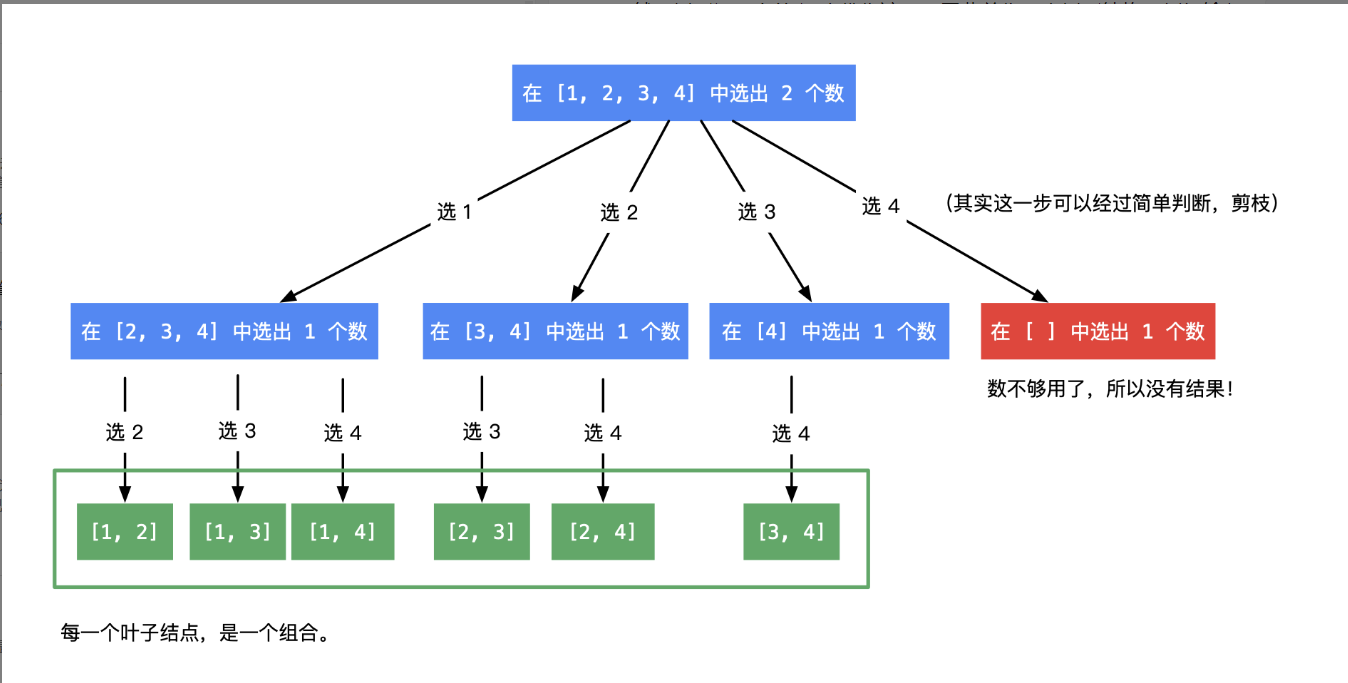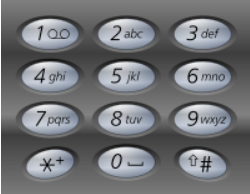77.组合
给定两个整数 n 和 k,返回范围 [1, n] 中所有可能的 k 个数的组合。
你可以按 任何顺序 返回答案。
示例 1: 输入:n = 4, k = 2 输出: [ [2,4], [3,4], [2,3], [1,2], [1,3], [1,4], ]
示例 2: 输入:n = 1, k = 1 输出:[[1]]
提示: 1 <= n <= 20 1 <= k <= n
- 思路:这是一道经典的不考虑顺序的问题,即选和不选问题,解决这道题有两种不同的代码,第一种是直接用递归进行选和不选操作,第二种用循环中包含递归,递归i从current开始,循环下去就是选和不选的问题。这道题关键是剪枝,当集合perm的长度加上区间[i,n]的长度比k小时,这时候就不用递归下去了。
- 流程图

static List<List<Integer>> res;public static List<List<Integer>> combine2(int n, int k) {res = new ArrayList<>();List<Integer> perm = new ArrayList<>();dfs(1, n, k,perm);return res;}private static void dfs(int current, int n, int k, List<Integer> perm) {//剪枝:perm长度加上区间 [current, n] 的长度小于 k,不可能构造出长度为 k 的 permif (perm.size() + (n - current + 1) < k) {return;}if (perm.size() == k) {res.add(new ArrayList<>(perm));return;}//选择当前current这个数perm.add(current);dfs(current + 1, n, k, perm);perm.remove(perm.size() - 1);//不选择current这个数dfs(current + 1, n, k, perm);}
static List<List<Integer>> res;public static List<List<Integer>> combine3(int n, int k) {res = new ArrayList<>();List<Integer> perm = new ArrayList<>();dfs2(1, n, k,perm);return res;}private static void dfs2(int current, int n, int k, List<Integer> perm) {if (perm.size() == k) {res.add(new ArrayList<>(perm));return;}for (int i = current; i <= n; i++) {//剪枝,当perm的长度加上区间[i,n]的长度不足k时,剪枝if (perm.size() + (n - i + 1) < k) {return;}perm.add(i);System.out.println("begin=="+perm);dfs2(i + 1, n, k, perm);perm.remove(perm.size() - 1);System.out.println("end=="+perm);}}
216.组合总和III
找出所有相加之和为 n 的 k 个数的组合,且满足下列条件:
只使用数字1到9 每个数字 最多使用一次 返回 所有可能的有效组合的列表 。该列表不能包含相同的组合两次,组合可以以任何顺序返回。
示例 1: 输入: k = 3, n = 7 输出: [[1,2,4]] 解释: 1 + 2 + 4 = 7 没有其他符合的组合了。
示例 2: 输入: k = 3, n = 9 输出: [[1,2,6], [1,3,5], [2,3,4]] 解释: 1 + 2 + 6 = 9 1 + 3 + 5 = 9 2 + 3 + 4 = 9 没有其他符合的组合了。
示例 3: 输入: k = 4, n = 1 输出: [] 解释: 不存在有效的组合。 在[1,9]范围内使用4个不同的数字,我们可以得到的最小和是1+2+3+4 = 10,因为10 > 1,没有有效的组合。
提示: 2 <= k <= 9 1 <= n <= 60
思路:和组合的思路差不多,只是最后得出结果和剪枝不同,最后的结果要相加等于n才能加进res中,剪枝条件时当相加结果大于n时,剪枝。
static List<List<Integer>> res;public static List<List<Integer>> combinationSum3(int n, int k) {res = new ArrayList<>();List<Integer> perm = new ArrayList<>();combinationSum3Core(n, k, 1, perm,0);return res;}private static void combinationSum3Core(int n, int k, int current, List<Integer> perm, int sum) {if (sum > n) {return;}if (perm.size() == k) {if (n == sum) {res.add(new ArrayList<>(perm));}return;}for (int i = current; i < 10; i++) {perm.add(i);sum += i;combinationSum3Core(n, k, i + 1, perm, sum);sum -= i;perm.remove(perm.size() - 1);}}
17.电话号码的字母组合
给定一个仅包含数字 2-9 的字符串,返回所有它能表示的字母组合。答案可以按 任意顺序 返回。 给出数字到字母的映射如下(与电话按键相同)。注意 1 不对应任何字母。
 示例 1:
输入:digits = “23”
输出:[“ad”,”ae”,”af”,”bd”,”be”,”bf”,”cd”,”ce”,”cf”]
示例 1:
输入:digits = “23”
输出:[“ad”,”ae”,”af”,”bd”,”be”,”bf”,”cd”,”ce”,”cf”]示例 2: 输入:digits = “” 输出:[]
示例 3: 输入:digits = “2” 输出:[“a”,”b”,”c”]
提示: 0 <= digits.length <= 4 digits[i] 是范围 [‘2’, ‘9’] 的一个数字。
思路:先把数字对应的字母表示下来,可以用map或者if,switch都可以,再将对应的字母按题目要求输出。
- 流程图:

static List<String> res;public static List<String> letterCombinations(String digits) {res = new ArrayList<>();if (digits.equals("")) {return res;}char[] chars = digits.toCharArray();char[] temp = new char[chars.length];List<String> words = new ArrayList<>();for (char aChar : chars) {words.add(digitsToWords(aChar));}letterCombinationsCore(digits,words, 0, temp);return res;}private static void letterCombinationsCore(String digits,List<String> words, int current, char[] temp) {if (current == digits.length()) {//Arrays.toString是打印数组内容,String.valueOf才是从char类型转化为String类型res.add(String.valueOf(temp));return;}String s = words.get(current);for (int i = 0; i < s.length(); i++) {temp[current] = s.charAt(i);letterCombinationsCore(digits,words, current + 1, temp);}}static String digitsToWords(char c) {switch (c) {case '2':return "abc";case '3':return "def";case '4':return "ghi";case '5':return "jkl";case '6':return "mno";case '7':return "pqrs";case '8':return "tuv";case '9':return "wxyz";default:return " ";}}
39.组合总和
给你一个 无重复元素 的整数数组 candidates 和一个目标整数 target ,找出 candidates 中可以使数字和为目标数 target 的 所有 不同组合 ,并以列表形式返回。你可以按 任意顺序 返回这些组合。
candidates 中的 同一个 数字可以 无限制重复被选取 。如果至少一个数字的被选数量不同,则两种组合是不同的。
对于给定的输入,保证和为 target 的不同组合数少于 150 个。
示例 1: 输入:candidates = [2,3,6,7], target = 7 输出:[[2,2,3],[7]] 解释: 2 和 3 可以形成一组候选,2 + 2 + 3 = 7 。注意 2 可以使用多次。 7 也是一个候选, 7 = 7 。 仅有这两种组合。
示例 2: 输入: candidates = [2,3,5], target = 8 输出: [[2,2,2,2],[2,3,3],[3,5]]
示例 3: 输入: candidates = [2], target = 1 输出: []
提示: 1 <= candidates.length <= 30 1 <= candidates[i] <= 200 candidate 中的每个元素都 互不相同 1 <= target <= 500
- 思路:和216题不同的地方,就是每个元素都可以重复使用,此时数据很多,必须要进行剪枝。现在不用sum了,而是每次递归都对目标数进行相减,如果下一个数大于目标数,则直接剪枝。要实现剪枝,最后就先对数组进行排序。
- 流程图

static List<List<Integer>> res;public static List<List<Integer>> combinationSum2(int[] candidates, int target) {res = new ArrayList<>();//用这个删除尾部元素比用ArrayList性能好一点Deque<Integer> perm = new ArrayDeque<>();Arrays.sort(candidates);combinationSum2Core(candidates, target, 0, perm);return res;}private static void combinationSum2Core(int[] candidates, int target, int current, Deque<Integer> perm) {if (target == 0) {res.add(new ArrayList<>(perm));return;}for (int i = current; i < candidates.length; i++) {//剪枝if (target - candidates[i] < 0) {break;}perm.add(candidates[i]);target -= candidates[i];System.out.println("递归之前:" + perm + "剩余:" + target);//因为可以重复,所以从i开始combinationSum2Core(candidates, target, i, perm);target += candidates[i];perm.removeLast();System.out.println("递归之后:" + perm + "剩余:" + target);}}
40.组合总和II
给定一个候选人编号的集合 candidates 和一个目标数 target ,找出 candidates 中所有可以使数字和为 target 的组合。
candidates 中的每个数字在每个组合中只能使用 一次 。
注意:解集不能包含重复的组合。
示例 1: 输入: candidates = [10,1,2,7,6,1,5], target = 8, 输出: [[1,1,6], [1,2,5], [1,7], [2,6]]
示例 2: 输入: candidates = [2,5,2,1,2], target = 5, 输出: [[1,2,2],[5]]
- 思路:这题和39题思路也差不多,只是多了个去重的步骤,因为题目中说解集不能包含重复的子集,要去重,思路都是大同小异的,先进行排序,让相同的数字相邻,并且同一层每个相同的数都使用首次出现的。
- 流程图

static List<List<Integer>> res;static int n;public static List<List<Integer>> combinationSum2(int[] candidates, int target) {res = new ArrayList<>();Deque<Integer> perm = new ArrayDeque<>();Arrays.sort(candidates);n = 0;combinationSum2Core(candidates, target, 0, perm);return res;}private static void combinationSum2Core(int[] candidates, int target, int current, Deque<Integer> perm) {if (target == 0) {res.add(new ArrayList<>(perm));return;}for (int i = current; i < candidates.length; i++) {//剪枝,让perm首位已经出现过的不会再出现if (i > current && candidates[i - 1] == candidates[i]) {continue;}if (target - candidates[i] < 0) {break;}perm.add(candidates[i]);target -= candidates[i];System.out.println("begin:" + perm + "remain" + target);combinationSum2Core(candidates, target, i + 1, perm);target += candidates[i];perm.removeLast();System.out.println("end" + perm + "remain" + target);}}

